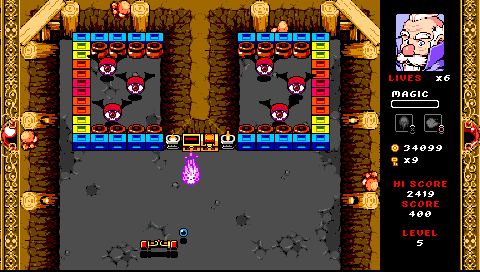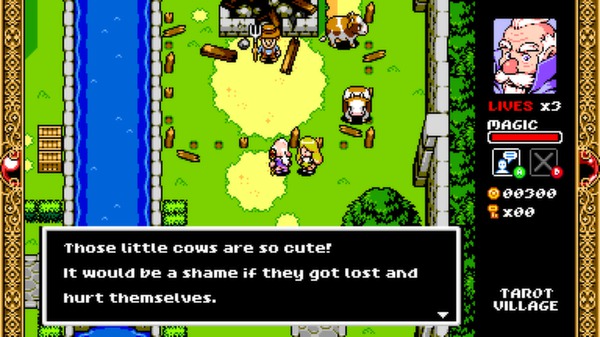
You remember Breakout, right? With a screen filled with rectangular blocks at the top and a “ball” you bounced off a bar at the bottom, destroying the blocks it hit. First released in 1976, it’s been remade and cloned over the past thirty-six years so often (Arkanoid, Alleyway) that even if you’ve never played the original, you’ve probably played some version of it.
Wizorb, from Montreal-based Tribute Games, de-abstracts the Breakout clone, wedging it into an aesthetic recalling mid-1990s home console RPGs like Shining Force. Chunky pixel sprites show a kingdom attacked by monsters and the wizard who is tasked with destroying them, using an orb (the ball) and a magic wand (the bar).
The game is divided into several worlds of twelve or so stages each. These stages are the Breakout levels, inhabited by both inanimate blocks and by monsters that function as moving blocks: Hit them a few times with the orb and they’ll die, but you have to make sure to take into account their movements as you bounce the orb around.
Where other Breakout clones added powerups that would drop from blocks as you destroyed them, Wizorb has magic spells that are fueled by a mana bar. Blocks will occasionally release a mana refill, an extra life, an attack or gold. This gold can be used to buy mana refills, extra lives or items that cause different effects like allowing you to stop the ball on the bar, or cause it to split into three.

The game becomes two different kinds of resource management: First, the gathering of money and mana as they fall from the blocks must be balanced against keeping the orb in the playing field. If you miss it with your wand, the orb falls off the bottom of the stage and you lose a life. While you can save your progress and restart at the beginning of your most recent level in any world, leaving a session mid-world will reset your score. It’s kind of a weird arcadey throwback, and it adds a level of challenge as you try to complete the world in a single go.
That’s where the second kind of management comes in: You will occasionally find a hidden shop in a level, allowing you to buy some of the aforementioned items. You can use money to buy extra lives and mana, but then you won’t be able to use it to rebuild the town that you visit in between worlds. It’s not a particularly deep city-building simulation—each building has a cost to rebuild, and that’s about it. But, for example, rebuilding the item shop becomes an investment in the future because you’ve got guaranteed access to a store in between worlds, instead of having to bet on finding one.
Wizorb’s release as a PSN Mini probably has one advantage over its other platforms (the game is available as an Xbox Live Indie Game, as well as for Windows, Mac and Linux): If you can use a PSP or Vita’s suspend function, there’s no need to save and quit in the middle of a world. You can break up your play without the score-reset punishment that require longer sessions on the console version.
It’s a nice little mash-up of nostalgias that plays off of how compartmentalized their objects were: like Puzzle Quest a few years ago, it slots great arcadey play in where the combat system would be. The light resource management ties the two segments together so that it doesn’t feel like the detached mess that “JRPG meets Breakout” seems like it should be.
Wizorb was developed by Tribute Games and published by Beatshapers. Our review is based on the PlayStation 3 Mini version available through the PlayStation Network. It is also available for PC and through the Xbox Live Indie Games marketplace.
Brian Taylor is really, really bad at Breakout clones, but he loves them anyway.